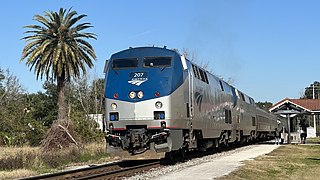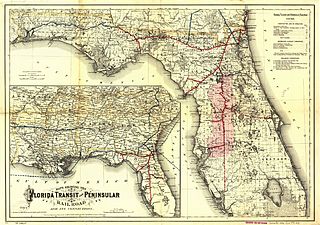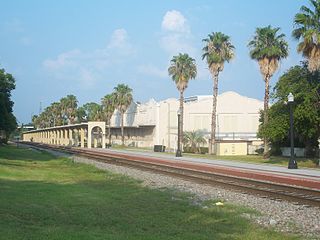
The Seaboard Air Line Railroad, which styled itself as "The Route of Courteous Service", was an American railroad that existed from April 14, 1900, until July 1, 1967, when it merged with the Atlantic Coast Line Railroad, its longtime rival, to form the Seaboard Coast Line Railroad. Predecessor railroads dated from the 1830s and reorganized extensively to rebuild after the American Civil War. The company was headquartered in Norfolk, Virginia, until 1958, when its main offices were relocated to Richmond, Virginia. The Seaboard Air Line Railway Building in Norfolk's historic Freemason District still stands and has been converted into apartments.

The South Florida Railroad was a railroad from Sanford, Florida, to Tampa, Florida, becoming part of the Plant System in 1893 and the Atlantic Coast Line Railroad in 1902. It served as the southernmost segment of the Atlantic Coast Line's main line. The line remains in service today and is now part of the Central Florida Rail Corridor in the Orlando metro area. The rest of the line remains under the ownership of CSX Transportation as part of their A Line.
The Florida Midland Railroad Company, Inc. is one of several short line railroads operated by Regional Rail, LLC in Florida. The Florida Midland Railroad operates two former CSX Transportation railroad lines including their former Lake Wales Subdivision, and their former Bartow Subdivision. It once had a third line from Wildwood to Leesburg that is now mostly abandoned. Florida Midland Railroad began operating the lines in 1987 and uses locomotives branded for the Florida Central Railroad, its sister railroad.

The South Central Florida Express, Inc. is a common carrier shortline railroad in southern Florida run by U.S. Sugar Corporation. Its trains operate from Sebring to Fort Pierce via Clewiston around the southern perimeter of Lake Okeechobee, and serves customers at 26 locations. With 171 miles (275 km) of track, the SCXF is the largest private agricultural railroad in the U.S.

The Silver Meteor is a long-distance passenger train operated by Amtrak between New York City and Miami, Florida. Introduced in 1939 as the first diesel-powered streamliner between New York and Florida, it was the flagship train of the Seaboard Air Line Railroad (SAL) and one of the flagship trains of its successor, the Seaboard Coast Line Railroad (SCL). The train was transferred to Amtrak when it took over intercity passenger rail service in 1971.

The Silver Star is a long-distance passenger train operated by Amtrak on a 1,522-mile (2,449 km) route between New York City and Miami via Washington, D.C., Richmond, Virginia, Raleigh, North Carolina, Columbia, South Carolina, Savannah, Georgia, Jacksonville, Florida, and Tampa, Florida. The Silver Star and its sister train in the Silver Service brand, the Silver Meteor, are the descendants of numerous long-distance trains that operated between Florida and New York for most of the 20th century.

The Florida Central and Peninsular Railroad was the final name of a system of railroads throughout Florida, becoming part of the Seaboard Air Line Railway in 1900. The system, including some of the first railroads in Florida, stretched from Jacksonville west through Tallahassee and south to Tampa. Much of the FC&P network is still in service under the ownership of CSX Transportation.

State Road 704 (SR 704), also known as Okeechobee Boulevard, is a 10.199-mile-long (16.414 km) east–west boulevard in the West Palm Beach area, known for being dangerous to pedestrians and bicyclists. It extends from an intersection with SR 7 at the border of West Palm Beach and Royal Palm Beach and just south of The Acreage at the western end to an intersection with SR A1A in Palm Beach at the east end.

State Road 710 is a 57-mile (92 km) northwest-southeast route connecting SR 70 near Okeechobee, three miles (5 km) from the northern tip of Lake Okeechobee in south central Florida, to Old Dixie Highway in Riviera Beach. Most of the route is also known as Bee-Line Highway and Dr. Martin Luther King Jr. Boulevard, as it parallels the railroad tracks maintained by CSX Transportation and used by Amtrak; and doesn’t have a turn or curve in the 48 miles (77 km) southeast of Sherman, except for a small bend northwest of North Palm Beach County General Aviation Airport. Near the middle of the highway, where Indiantown is located, the route is also known as Warfield Boulevard, named after S. Davies Warfield, the president of the Seaboard Air Line Railroad who originally built the adjacent railroad tracks.

U.S. Route 98 is a major east-west thoroughfare through the U.S. state of Florida. Spanning 670.959 miles (1,079.804 km), it connects Pensacola and the Alabama/Florida state line to the west with Palm Beach and the Atlantic coast in the east. It is the longest US road in Florida, as well as the longest US road in any state east of the Mississippi River.
The Seaboard Air Line Depot can refer to the following former and active train stations previously used by the Seaboard Air Line Railroad, many of which are listed on the National Register of Historic Places:

Wildwood station is a bus station, and former train station, in Wildwood, Florida. It serves Amtrak Thruway buses and formerly served trains for Amtrak and other rail companies. The station is located on 601 North Main Street in Wildwood, Florida. Along with the northern terminus of Florida's Turnpike, the station gave Wildwood a reason to refer to itself as "The Crossroads of Florida."

The Seaboard–All Florida Railway was a subsidiary of the Seaboard Air Line Railroad that oversaw two major extensions of the system in the early 1920s to southern Florida on each coast during the land boom. One line extended the Seaboard's tracks on the east coast from West Palm Beach down to Fort Lauderdale and Miami, while the other extension on the west coast extended the tracks from Fort Ogden south to Fort Myers and Naples, with branches from Fort Myers to LaBelle and Punta Rassa. These two extensions were heavily championed by Seaboard president S. Davies Warfield, and were constructed by Foley Brothers railroad contractors. Both extensions also allowed the Seaboard to better compete with the Florida East Coast Railway and the Atlantic Coast Line Railroad, who already served the lower east and west coasts of Florida respectively.

CSX Transportation's Carters Subdivision is a segment of CSX's A Line running from Poinciana southwest to Lakeland. The Carters Subdivision ends just west of Downtown Lakeland at Lakeland Junction, where it continues west as the Lakeland Subdivision and connects to the Vitis Subdivision.
CSX Transportation's Valrico Subdivision is a railroad line in Central Florida. It serves as CSX's main route through a region of Central Florida known as the Bone Valley, which contains the largest known deposits of phosphate in the United States.
The Wildwood Subdivision is a railroad line owned by CSX Transportation in Florida. It runs along CSX's S Line from Baldwin south to Zephyrhills via Ocala and Wildwood for a total of 155.7 miles. The S Line is CSX's designation for the line that was the Seaboard Air Line Railroad main line from 1903 to 1967.

The Yeoman Subdivision is a railroad line owned by CSX Transportation in Florida. It runs along CSX’s S Line from Zephyrhills south to just east of Tampa via Plant City for a total of 31.2 miles.

The Atlantic Coast Line Railroad's Haines City Branch was a railroad line running from their main line in Haines City, Florida south through southern Central Florida. The line notably ran through Lake Wales, Avon Park, Sebring, and Immokalee and would stretch as far south as Everglades City upon its completion in 1928. Everglades City would be the southernmost point the entire Atlantic Coast Line Railroad system would ever reach. The Haines City Branch was one of the Atlantic Coast Line's major additions to its Florida network, much of which was previously part of the Plant System.
The Atlantic Coast Line Railroad's Lakeland—Fort Myers Line was one of the railroad company's secondary main lines in Central and Southwest Florida. It was built incrementally in the late 1800s and early 1900s. Parts of the line are still active today.
The Atlantic Coast Line Railroad's DuPont—Lakeland Line was a historic rail line in southern Georgia and the northern west coast of Florida. On employee timetables, the line was actually divided into the DuPont—High Springs Line and the High Springs—Lakeland Line. The line was primarily used for freight, though some passenger services ran on parts of it in Florida. While parts of the line were built as early as 1863, the full line was not complete until 1913. Parts of the line in Florida are still active today.

























